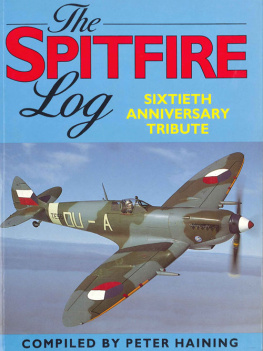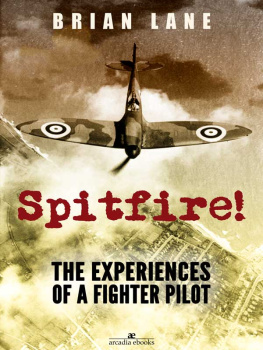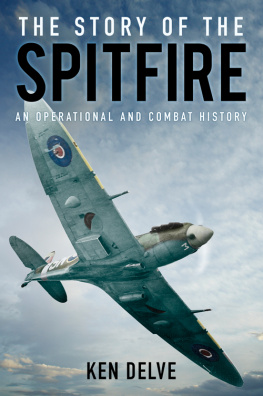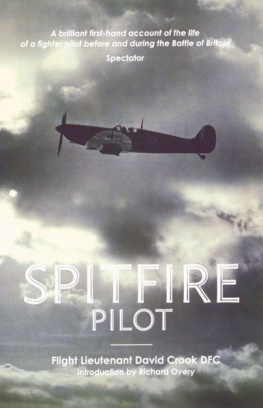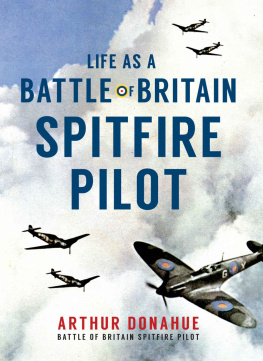
For
My Father
who lived this magnificent era
The author would like to thank the following publishers, magazines and agencies for permission to use their material in this book: Associated Newspapers, Horizon magazine, Chatto & Windus, The Daily Telegraph, Ziff-Davis Publishers, Methuen, The Sunday Times, Life magazine, Aeroplane magazine, Punch, The Times, The Royal Airforce Review, The Daily Express, John Murray (Publishers), Air Ministry Records Office, the Imperial War Museum, the British Museum, the British Newspaper Library, the BBC Sound Archives, Messrs Vickers Ltd. The photographs are primarily from the authors own collection, but acknowledgement is also given to Alexander McKee, The Photo Source, Popperfoto, British Film Institute, Universal Pictures, Associated British Films, Rank Distributors and United Artists.
Contents

More than half a century since it went into mass production, and in an era when jets fly around the world and space has been conquered, the Spitfire remains the most recognisable, beautiful and charismatic of all aeroplanes. Although fewer than fifty examples are still flying worldwide, the achievements of this fighter plane during the Second World War made it a legend that brought a silver lining to the storm clouds over Britain; it became a reflection of the indomitable national character when under threat. One of the Spitfires longest-serving pilots, Group-Captain Duncan Smith, calls the plane a lady with no vices.
The sight and sound of the Spitfire has made it one of the major attractions at air shows, and enthusiasts all over the world continue to hunt for surviving examples which have turned up in abandoned hangars, at the bottom of lakes and even beneath the fields where they crash-landed in northern France and Holland. One persistent rumour has it that half-a-dozen new models, still in their delivery crates, are buried deep in a mineshaft in Australia! To help in the restoration of those that come to light, several specialist services have sprung up to manufacture the precious steel and aluminium parts which, during the war years, were made from the pots and pans donated by British housewives to the war effort. A restored Spitfire is today reckoned to be worth in excess of 500,000; when originally built they cost 5,000.
The unique capabilities of the aircraft and its performance against the Luftwaffes front-line fighter, the Me109, continue to provoke fierce arguments in the press between pilots and historians, in particular the revisionists who have argued that not only was the plane seriously flawed, but so costly to produce that it contributed to Britains post-war industrial decline when it could not be adapted to commercial use. Such disputes notwithstanding, the Spitfire has generated a virtual industry in souvenirs, including books, videos, paintings, commemorative pottery and a Spitfire Society with members all over the world. Nor is this interest confined to men: Carolyn Grace, whose late husband restored a rare two-seater Spitfire found in pieces in Scotland, now flies the aircraft at displays around the country; and, at the time of writing, a film, Spitfire Girls, about women pilots in World War II, is in production.
Despite the many fighters that have subsequently taken on its role in the RAF, the Spitfire remains in many peoples eyes the services most potent symbol. It has a tradition that the passage of time has not dimmed and an appeal to all ages. The only thing that has changed is that the plane built to kill now simply thrills.
Peter Raining
January, 1997

March 6, 1936, was a typical early Spring day in England. A covering of high, grey clouds had remained virtually unbroken since dawn and, in the far south of the country, there was a light wind blowing in from the English Channel across Southampton. On the outskirts of this town, at Eastleigh Aerodrome, a small group of men were gathered around a sleek, elegant single-seater aircraft with a fixed-pitch airscrew and stub exhausts. It was painted in a pale blue enamel and its only markings were the registration letters K5054.
At first glance, it might have seemed like any other day at this industrious little airport beside the River Itchen, a mile or two from its junction with Southampton Water and the appropriately named River Test. There was the noise of engines running, the sound of mechanics busy inside the various hangars, and the intermittent take-off and landing of small aircraft.
But the little group of men, all employees of the Vickers Supermarine Aircraft Company, were, in fact, about to witness a piece of aeronautical history. Sixty years ago they saw a legend born.
At the centre of the group stood a big, thick-set man, Flying Officer Joseph Summers, known to one and all by the nickname Mutt. Despite his size, Mutt Summers was renowned for his amazingly quick reactions and his exceptional natural talent as a pilot. Friends had been known to say of him that you could fix a propeller to a kitchen table and he could fly it, and he himself admitted that he flew planes more by the seat of his pants than by instruments. Yet even airmen who were sticklers for doing it by the book, and disapproved of his intuitive way of flying, were of the opinion that he was probably the leading test pilot of his generation.
Certainly Mutt had an impressive background. Born in London in 1904, he had as a child become fascinated by the exploits of the World War I pilots, and eagerly joined the Royal Flying Corps as soon as he was old enough. He spent five years at Martlesham Heath near Ipswich, which since 1916 had been the official Aeroplane and Armament Experimental Establishment. Here he had proved himself an outstanding pilot, at a centre which had earned itself a reputation for the most accurate and thorough testing of new aircraft. Indeed, it was said that a Martlesham Report could not be bettered for comprehensiveness and impressive weight of detail, while a Martlesham pilot could fly anything a designer wanted to put into the air. Standards were, quite simply, higher than anywhere elseand the pilots were also, beyond question, the very best.
In 1929, however, Mutt Summers had resigned his commission and left Martlesham on being offered the job of chief test pilot at Vickers, as replacement for Tiny Schofield, tragically killed in an accident. Despite the fact that there were perhaps elements of his flying not in the Martlesham tradition, Mutts individualistic style was precisely what Vickers required for their various high-speed prototypes. From that year on, he was the pilot who first took up any new aircraft.
Summers size was matched by his personalityoutgoing and ebullient, he enjoyed not only the challenge of the test flights, but also the excitement and glamour that went with them. Unlike many of his contemporaries, Mutt did not shrink from publicity, and revelled in the awe in which he was widely held. When he flew anything other than single-seater machines, observers who went along with him returned with breathless tales of his ability. These admirers said that you could tell just what a good test pilot he was simply by the look of his mouth and his knuckles when he was in the air.
Standing beside Summers as he prepared to climb into the pale blue prototype was a thin, sandy-haired, rather stooped man, his florid face drawn with an inner pain he was obviously doing his best to conceal. He was Reginald Joseph Mitchell, known as R. J., an aeroplane designer of undoubted genius who was about to watch the fulfilment of a dream. For the prototype was hisat that moment quite untried, but destined to make his name immortal, and in time to play a major part in saving his generation from one of the most hideous tyrannies that ever set out to enslave mankind.
Next page
